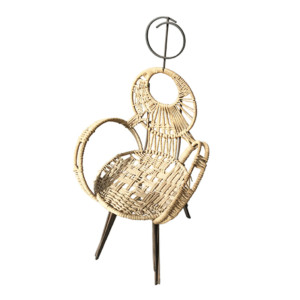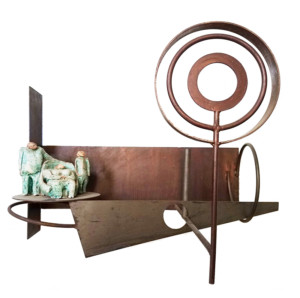Renato Bassoli
Rigorous, thoughtful, sincere; an artist in whom a deep and fertile imagination was always tempered by a discerning eye, Italian born Renato Bassoli produced some of the most original and interesting furniture, sculpture and ceramics associated with the 1950’s.
Unfortunately, there is little information about Rentao Bassoli’s early life. Bassoli was born in Milan in 1915. He attended the renowned Brera Academy, as well as the Scuola del Castello from 1937 – 1948, but his studies were interrupted during WW2, when he was interred in a camp in Germany.
Bassoli first worked as a graphics designer, and also designed theater sets, but his passion was to be a sculptor., and he soon began to concentrate on his own creative work in sculpture, ceramics and jewelry. At some point, he moved to Paris to follow his artistic career.
His work, which he pursued with passion throughout his life, is impregnated with a deep humanism. The path that he chose for himself was ” the path of artistic and professional discipline”. The simple and modest expression of his goal as an artist was — “I endeavor always to do my best, and above all, I try to create things and objects that are good – technically prefect and naturally pleasing to the eye”. This philosophy created a body of work that was rich, powerful and exuberant.
Bassoli’s work is characterized by a deep humanity, exuberance and joie de vivre. His art was intended to celebrate the existence of art and of life – exuberance and fantasy expressed in a visual manner, and executed with faultless technique. This quality in Bassoli’s work is not surprising, as the works were born of spontaneous inspiration.
It was, perhaps, inevitable that human figures found their way into his art, as can be seen in some of his ceramics and sculptures, and most clearly in the delightful furniture that he created in human forms. These were intended to address our place in our environment. In his late sculptures – welded steel armatures that resembled stage sets, he shows desolate landscapes with solitary figures, much as De Chirico did in his paintings.
A number of exhibitions have confirmed the value of Bassoli’s work. His ceramics have been favorably compared with those of Lucio Fontana in the ways that they explore space and time.
These concepts were introduced into his furniture designs as well, with the use of flat surfaces and the interplay of positive and negative space. he was also able to capture a remarkable fluidity and spontaneity in certain pieces of his furniture, which were executed in continuous, flowing metal wire, and bring to mind Hector Guimard and Alexander Calder.
For reasons known only to himself, Bassoli kept most of the furniture that he created. Upon his death in 1981, the contents of his atelier came on the market at auction, and were snapped up immediately by dealers, collectors and museums, and are now quite rare on the market. The musee des arts decoratifs in Paris purchased a wonderful chair. A ceramic work of his is in the Indianapolis Museum of Art, and there were several wonderful pieces of anthropomorphic furniture exhibited in “Die Funfziger, Stilkonturen eines Jahrzents” at the Museum Villa Stuck in Munich, Germany, in 1984.
This biography is copyright-protected, and cannot be copied whole or in part without permission of Audrey Friedman.
Showing all 2 results
-
$0.00
-
$0.00



